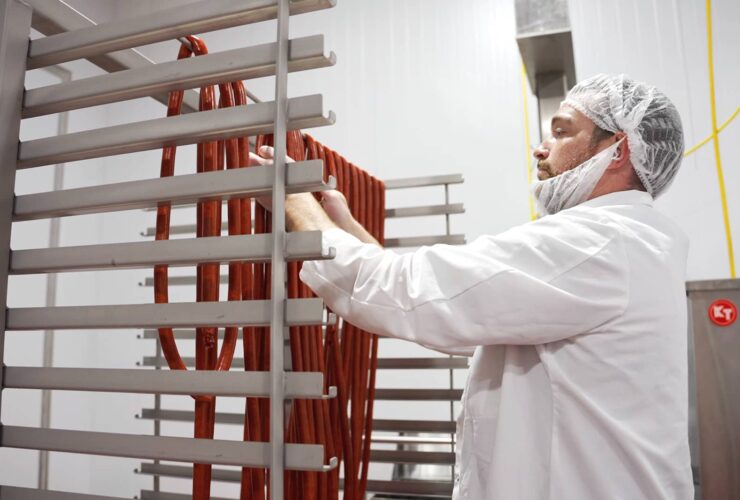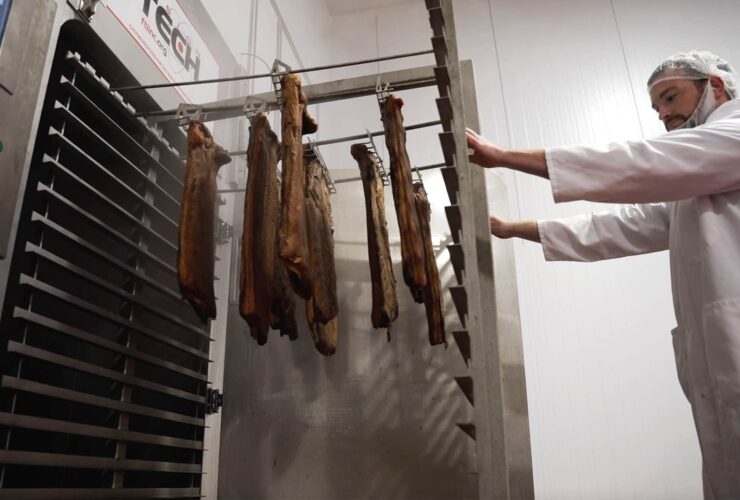Chain-driven dampers were the industry standard for decades when it came to “controlling” the breakpoint in an industrial smokehouse or dehydrator.
If you have an older oven, or one manufactured in Europe, chances are the dampers are driven and kept at a 90-degree angle from each other using chains and sprockets.
While this design was revolutionary in the industry when it was first introduced, new technology and updated designs have made chain-driven dampers a thing of the past — and a very ineffective way of controlling the breakpoint in an oven.
In order to understand why chain-driven dampers should be avoided in a smokehouse or dehydrator, it’s beneficial to know what the breakpoint is and how it’s controlled.
Understanding the Breakpoint
The breakpoint is the location where two opposing air streams (high-velocity air and low-velocity air) in the oven cabinet collide and move either horizontally or vertically through the cabinet to cook the product. It is formed and controlled through the use of a fan and alternating dampers located above the supply ducts.
In order to create opposing air streams in the oven, the dampers need to remain aligned at exactly 90° from each other. This perfect alignment allows the breakpoint to form in the same locations in the oven to consistently cook your product.
As small as a 2° deviation from the 90° alignment, the breakpoint will move to a different location on the oven wall, resulting in air moving over your product in different locations for an inconsistent cook.
Consistency and improved yields come when the breakpoint hits the exact same locations every time as it moves throughout the oven.
You can learn more about the breakpoint and how it’s controlled in our Oven Breakpoint Guide.
Avoid Chains at All Costs
While chain-driven dampers were an industry standard for decades, they fail miserably at keeping the dampers in perfect alignment throughout the cook cycle — and should be avoided when purchasing a new smokehouse or dehydrator.
Here’s why:
Loose Breakpoint
As mentioned above, a 2° deviation from perfect alignment is all it takes to move the breakpoint to a different location along the oven wall. This jumping around of the breakpoint ruins consistency and yields, as the breakpoint never forms in the same place twice.
Chains are not strong enough nor consistent enough to hold the dampers in perfect alignment.
Turning on the main fan in the smokehouse or dehydrator is enough in a chain-driven system to cause the dampers to shake, making the breakpoint move erratically through the oven. Just look at this video we took to see how much a chain-driven damper system moves when the main fan is turned on.
Inconsistent Cooks
Product consistency in a smokehouse or dehydrator relies on consistent airflow in the oven.
When the breakpoint hits the exact same location along the oven wall or floor on every pass and in every batch, your product will cook the same each time.
But when the dampers bounce around, as they do in a chain-driven damper system, the breakpoint does not consistently hit the same location, resulting in the product being cooked differently every time you run your oven.
A loose breakpoint cannot produce a consistent product, and only results in lower yields, inconsistent cooking, and drastic color variation of product throughout the oven.
Maintenance Headaches
On top of the breakpoint and product consistency issues, a chain-driven damper system is a headache for maintenance.
Ask any team responsible for maintaining an oven with a chain-driven damper system, and you’ll hear story after story of problems with the chains:
- Chains stretch causing the dampers to fall out of alignment and wobble as air from the main fan hits them.
- Chains need tensioners to tighten them back up and work correctly.
- Chains require regular lubrication to keep them from wearing out and breaking.
- The dampers need to be aligned frequently, sometimes on a daily basis.
The time spent alone inspecting and maintaining a chain-driven damper system is enough for most people to avoid the chain when purchasing a new smokehouse or dehydrator, especially in smaller processing plants that don’t have a team dedicated to only maintaining their ovens.
A Better Solution
Keeping the dampers in perfect alignment and controlling the breakpoint isn’t impossible.
New technology and designs have been used in recent years to improve upon the chain-driven system and bring a new level of consistency to products being cooked in industrial smokehouses and dehydrators.
Many manufacturers, especially in America, are switching to a jackshaft system to control the dampers.
Rather than chains that stretch or bounce when the main fan is turned on, a jackshaft system uses a stainless steel shaft to keep the dampers perfectly aligned at 90° as they rotate. Gears located at the end of the shaft turn the dampers as well as connect to the shaft coming from the motor.
These shafts and gears never stretch, never need tensioners, rarely (if ever) fall out of alignment, and need little to no maintenance.
With a jackshaft system, a consistent breakpoint is achieved, consistent product is cooked, and your maintenance team will stop singing the chain-driven woes.




